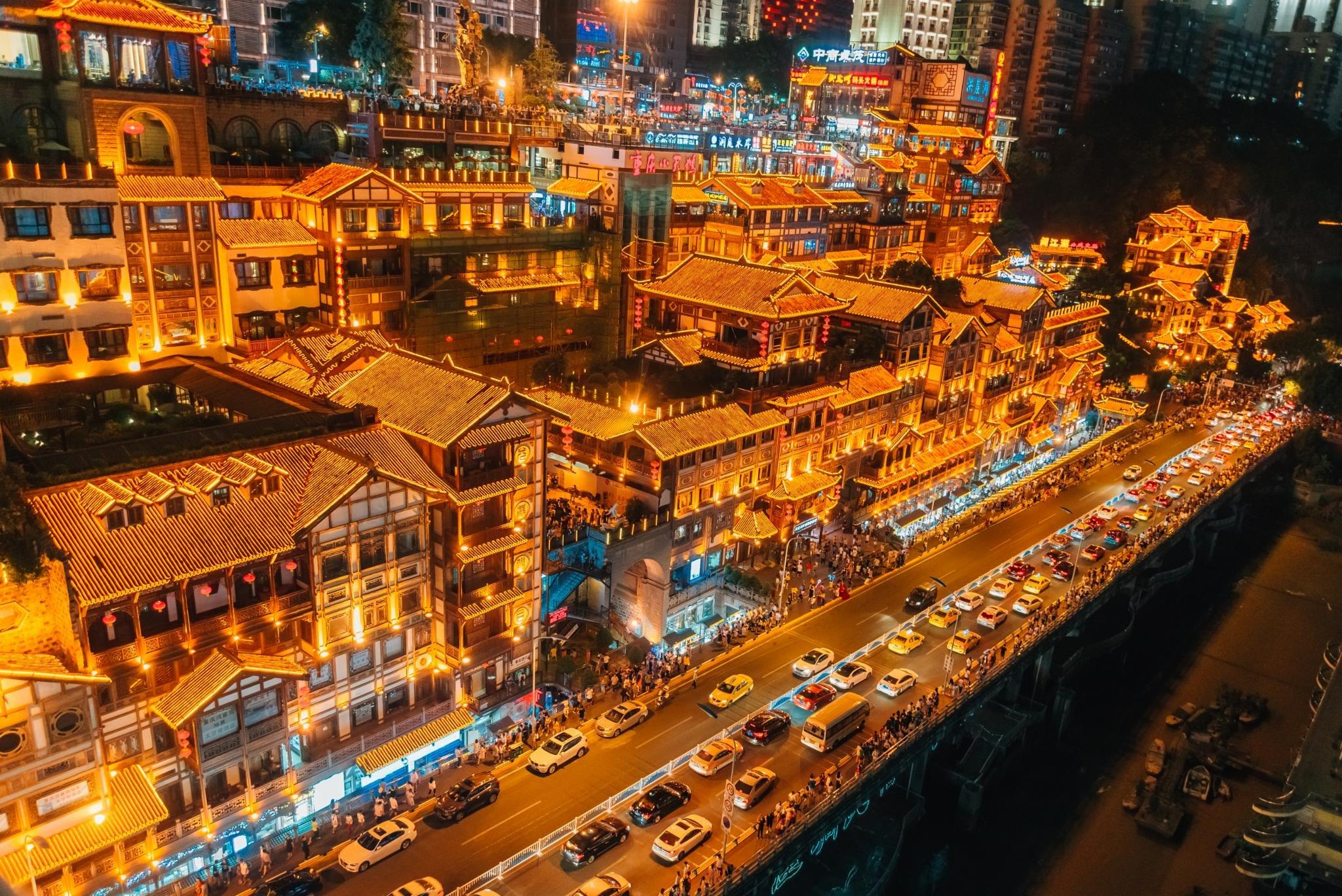
Hongya Cave Folk Custom Scenic Area
Hongya Cave Folk Customs Scenic Area is a great place to explore the old streets of Chongqing, enjoy the scenery of the two rivers, and savor local delicacies. The Hongya Cave Commercial Street is located at Cangbai Road in Yuzhong District, in the riverside area where the Yangtze River and the Jialing River meet. It is mainly composed of the "stilted buildings" with traditional Bayu architectural characteristics, built along the mountain and the river. The night view is extremely beautiful.
The Hongya Cave Folk Customs Scenic Area consists of four parts: the Zhiyanhe Bar Street, the Tiancheng Lane Bayu Style Street, the Grand Feast Food Street, and the Exotic Urban Balcony. With the stilted buildings with traditional Bayu architectural characteristics as the main body, and following the terrain, through mountain - building techniques such as tiered platforms, stilt construction, staggered stacking, and cliff - side building, these buildings are gathered together. When night falls and the lights are all on, it is truly a scenic wonder in the mountain city.
For food, shopping, and sightseeing, on both sides of the Hongya Cave Folk Customs Scenic Area are dense stilted buildings. There are as many as 11 floors from the riverside road at your feet to the Cangbai Road at the top. Each floor has different contents, including restaurants, snack streets, bars and cafes, as well as specialty shops. The top floor is the Exotic Urban Balcony, which can be reached directly by elevator. Standing on the viewing platform, you can overlook the confluence of the two rivers in the distance and enjoy the boundless scenery.
1. Why Visit Hongya Cave?
A real-life Miyazaki fantasy meets Chongqing’s layered mountain-city magic.
Hongya Cave enchants visitors with its vertigo-inducing architecture resembling a stacked “stilted castle” glowing at night. Its uncanny resemblance to *Spirited Away*’s bathhouse (though unofficially) and surreal multi-level maze blending shops, teahouses, and hidden cultural gems make it a must-see for its fusion of whimsy and authentic Bayu culture.
2. Architectural Wonder Decoded
A. Stairway to Miyazaki’s Imagination
The cascading wooden towers and glowing nightscape evoke *Spirited Away*’s dreamscape. While no official link exists, the 11-story structure’s staggered balconies, glowing red lanterns, and riverside perch create a cinematic illusion.
B. Layer-by-Layer Illusions
-
River Color Mystery: Upper floors face the Jialing River (emerald green), while lower floors overlook the Yangtze (muddy yellow). The height difference creates a magical color split.
-
Navigation Tricks: The 1st floor on maps is actually the 11th! Find the “time-warp” elevator: exit on “4F” to reach a street-level road.
-
3D City Quirks: A hotpot restaurant’s basement has a riverside terrace; follow the smell of chili oil to orient yourself.
3. Best Photo Spots
-
Across Jialing River Bridge: Capture the full golden glow at dusk (7:30-9:00 PM).
-
Hongya Cave Viewing Deck (11F): Frame the cliffside panorama with the neon skyline.
-
Qiansimen Bridge Pedestrian Walkway: Shoot the “floating” lights reflecting on the river.
4. Routes & Top Attractions
A. Efficient Route (2-3 Hours)
Start at Xiaoshizi Metro Station → walk 8 mins to Kui Xing Tower (find the “vanishing bridge” illusion) → descend via Linfjiangmen Stairs to Hongya Cave’s rooftop (11F). This “time-travel” path skips crowds and highlights Chongqing’s spatial paradoxes.
B. Hidden Gems
-
Intangible Heritage Workshop (5F): Escape crowds with hands-on bamboo weaving or Shu embroidery (free demos daily 10 AM-4 PM).
-
1980s Chongqing Memory Museum (9F): Vintage posters and rotary phones reveal the city’s pre-skyscraper charm.
-
Teahouse at Cliff’s Edge (B1): Sip chrysanthemum tea on a terrace “floating” above the Yangtze.
5. Unique Experiences
A. Cultural Immersion
-
Join a DIY Hotpot Spice Class (3F, 50 RMB, book via WeChat “HongyaCulture”).
-
Watch Chuan Opera Face-Changing Shows nightly at 7:30 PM (1F plaza).
B. Secret Adventures
-
Reverse Exploration: Start at DaiJia Alley Cliff Walk for a quiet descent into Hongya Cave.
-
Time Capsule Elevator: Ride the Hongya Hotel’s lift to see 1970s Chongqing photos.
-
Soundmark at 4F Bridge: Listen for the Yangtze’s deep rumble vs. Jialing’s gentle flow.
6. Hotels & Transport
A. Chongqing Hotels Near Hongya Cave
-
Luxury: Niccolo Chongqing (1,200-2,000 RMB/night, 10-min walk) – infinity pool overlooking Jiefangbei.
-
Mid-Range: Atour Hotel (400-600 RMB, 8-min walk) – minimalist rooms near Chaotianmen Square.
-
Budget: Sleepy Panda Hostel (80-150 RMB, 12-min walk) – rooftop bar with cave-view.
B. Getting There
-
Metro: Line 1/6 to Xiaoshizi Stn (Exit 9).
-
Bus: Routes 111/114/135 to Linjiangmen.
-
Ride-Hail: Enter “Hongya Cave Tourist Center” to avoid drop-off chaos.
7. Pro Tips
A. Tickets
Free entry, but Hongya Cave Museum (9F) requires 30 RMB (book via Chongqing Liangtian mini-program).
B. Shoes & Gear
Wear non-slip sneakers for steep stairs. Pack a mini flashlight for dimly lit alleys.
C. Navigation Hacks
-
3D Map Mantra: “Up for metro tracks, down to the river, lost? Follow chili fumes!”
-
Restroom Hunt: 3F toilets hide behind dried chili stalls; B1 restrooms face the river.
8. FAQs
A. History
Built in 2006 atop ancient dock ruins, Hongya Cave revives traditional Bayu stilted architecture.
B. Hours
Shops: 10 AM-11 PM; Lights on until midnight.
C. Nearby Attractions
-
Chaotianmen Square (500m): Yangtze & Jialing rivers’ confluence.
-
Jiefangbei CBD (1km): Skyscraper shopping and spicy street food.
-
Ciqikou Ancient Town (12km): Ming-era porcelain village.
D. City Connections
-
Yangtze Cable Car (3km): Ride the “flying ferry” over the river.
-
Wulong Karst (2h by train): Avatar-like limestone pillars.
E. Must-Eat Nearby
-
Zeng Lao Yao Hotpot (800m): Cave-dining with fiery broth.
-
Suan La Fen at Hao Wei (300m): Sour-spicy sweet potato noodles.
9. Final Notes
Hongya Cave isn’t just a destination—it’s a vertical adventure blending optical illusions, sensory thrills, and living history. Let its labyrinthine layers rewrite your understanding of urban space.
Overview
Info
Review